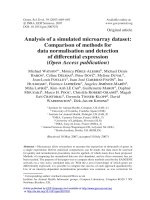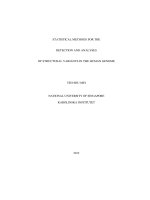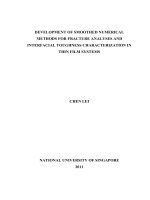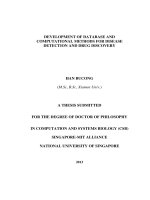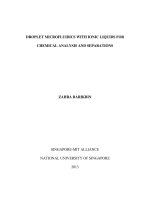Novel methods for quantitative analysis and evaluation of effects of chronic exposure to microcystins by capillary electrophoresis and metabolomic studies
Bạn đang xem bản rút gọn của tài liệu. Xem và tải ngay bản đầy đủ của tài liệu tại đây (3.81 MB, 177 trang )
NOVEL METHODS FOR QUANTITATIVE ANALYSIS AND
EVALUATION OF EFFECTS OF CHRONIC EXPOSURE TO
MICROCYSTINS BY CAPILLARY ELECTROPHORESIS AND
METABOLOMIC STUDIES
GRACE BIRUNGI
NATIONAL UNIVERSITY OF SINGAPORE
2010
NOVEL METHODS FOR QUANTITATIVE ANALYSIS AND
EVALUATION OF EFFECTS OF CHRONIC EXPOSURE TO
MICROCYSTINS BY CAPILLARY ELECTROPHORESIS AND
METABOLOMIC STUDIES
GRACE BIRUNGI (MSc)
A THESIS SUBMITTED FOR THE DEGREE OF DOCTOR OF
PHILOSOPHY
DEPARTMENT OF CHEMISTRY
NATIONAL UNIVERSITY OF SINGAPORE
2010
ii
Acknowledgements
I would like to extend my sincere gratitude to my supervisor Professor Sam Fong Yau Li for
his guidance during my graduate studies.
Financial supports from the Organization for Women in Science for the Developing World
(OWSDW) under the auspices of the academy of science in the developing world (TWAS),
National University of Singapore (NUS), and EWI (MEWR C651/06/144) are gratefully
acknowledged.
I would also like to extend my appreciation to Dr. Yuk Chun Chiam-Tai and Mr. Seng Chen
Tan of Public Utilities Board (PUB) of Singapore’s national water agency, for their assistance
in the collection of the water samples, Professor Hanry Yu and Ms Teo Siow Thing of
Department of Physiology NUS for provision of cell lines used in the study; and to Ms. Saw
Marlar for assistance in flow cytometry experiments. The assistance and training offered by
Madam Han Yanhui and Mr. Wong Chee Ping of NMR lab is also appreciated.
To the members of Professor Sam Li’s lab who provided a suitable learning environment,
encouragement and support, thank you. Furthermore, I would like to acknowledge Mbarara
University of Science and Technology, Uganda, for the opportunities and support in my
academic growth.
To my family, your support and encouragement has kept me going. Thank you.
Contents
Acknowledgements ii
Contents iii
Abstract/Summary viii
List of Tables x
Table of Figures xi
List of Abbreviations xiv
CHAPTER 1- INTRODUCTION 1
1.0 Introduction 1
1.1. Algal Toxins 1
1.2 Statement of the Problem 10
1.3 Scope of Research 12
1.3.1 Research Aims/Objectives 12
1.4. Capillary Electrophoresis - Basic Principles 14
1.4.1 Sample Introduction 16
1.4.2 Sample Separation 20
1.4.3 Detection in Capillary Electrophoresis 24
1.4.4 Modes of Capillary Electrophoresis 25
1.4.5 Pre-concentration Techniques in Capillary Electrophoresis 28
1.4.6 Online Sample pre-concentration methods 29
1.5. Metabolomics and Metabonomics - Introduction 35
iv
1.5.5 Metabolomics and Metabonomics Approach in the Study of Microcystin Toxicity
46
CHAPTER 2 –DEVELOPMENT OF METHODS OF ANALYSIS 48
2.0 Development of CE Methods for the Determination of Cyanotoxins 48
2.1 CZE and MEKC Methods for Determination of Microcystins LR, RR, YR and
Nodularin. 48
2.2 CZE and MEKC Materials and Methods. 49
2.2.1. Experimental 49
2.2.2 Chemicals 49
2.2.3 Sample Preparation 50
2.2.4 Selection of Background Electrolyte and Detection Mode 52
2.2.5 Extraction of Nodularin and Microcystins LR, RR and YR 52
2.3. Results and discussion 53
2.3.1 Detector and Background Electrolyte (BGE) Choices 53
2.3.2 CZE Separation Conditions 55
2.3.3 MEKC Separation 57
2.3.4 Comparison of the CZE and MEKC Methods. 57
2.3.5 Pre-concentration 58
2.3.6 Tap Water Analysis 62
2.3.7 Reservoir Water Sample Analysis 63
CHAPTER 3 – DEVELOPMENT OF MEEC 64
3.0 MEEC Principle 64
3.1 Development of Microemulsion Electrokinetic Chromatography (MEEC) Method for
the Determination of Cyanotoxins in Water. 65
v
3.2 MEEC Method Development 66
3.2 .1 Effect of Absorption Wavelength 66
3.2.2 Effect of Background Electrolyte Concentration 67
3.2.3 Effect of Surfactant 68
3.2.4 Effect of Co-surfactant 71
3.3 Pre-concentration 73
3.3.1 Online Pre-concentration Using a Salt 73
3.3.2 Online Pre-concentration with the Aid of a Water Plug 74
3.4 Real Sample Analysis 78
3.5 CZE, MEKC and MEEC Comparison 80
3.6 CE (CZE, MEKC, MEEC) Compared to HPLC 81
CHAPTER 4 – METABOLOMICS APPROACH TO INVESTIGATION OF
MICROCYSTIN TOXICITY 84
4.0. Development of Metabolomics Approaches for the Investigation of the Effect of
Exposure of a Human Cell Line to Non Cytotoxic Amounts of Microcystins. 84
4. 1 Methodology and Experimental 86
4.1.1 Materials 86
4.1.2 Instrumentation 86
4.1.3 Cell Culture 87
4.1.4 Assessment of the Effect of Microcystins on Cell Viability 87
4.1.5 Sample Preparation 89
4.1.6
1
H NMR Analysis 89
4.1.7 Analysis by Direct Injection Mass Spectrometry (DIMS) 90
vi
4.1.8 Data Analysis 91
4.2. Results 91
4.2.1 Assessment of Cell Viability 91
4.2.2 NMR Results 96
4.2.3 MS Results 98
4.2.4 Principal Component Analysis (PCA) 99
4.3 Discussion 108
4.3.1 Amino acids 110
4.3.2 Organic acids 118
4.3.3 Lipids and phospholipids 119
4.3.4 Purines and Pyrimidines 126
CHAPTER 5 – CONCLUSION 127
5.0 Conclusion 127
5.1 Quantitative Analysis of Cyanotoxins Using Capillary Electrophoresis (CE) 127
5.2 Evaluation of Effects of Chronic Exposure of a Human cell Line to Microcystins 128
5.3 Future Work 130
6.0 References 132
7.0 Publications 140
8.0 Appendices 142
Appendix 1 Sample NMR Results 142
Appendix 2 Graphs showing Component Variations 143
Appendix 3 Glycolysis/Gluconeogenesis 152
Appendix 4 Amino Acid Variation 153
vii
Appendix 5 Organic Acids Table of Results 156
Appendix 6 Lipids and Phospholipids Sample Results 157
Appendix 7 Inositol Phosphate Metabolism 160
Appendix 8 Glycerophospholipid Metabolism 161
Appendix 9 Pyrimidine Metabolism 162
viii
Abstract/Summary
This thesis describes capillary electrophoresis (CE) methods for separation and quantification
of cyanotoxins in water; and “metabolomic” and “metabonomic” approaches for investigation
of the effect of exposure of a human cell line to low amounts of microcystins.
Incidences of toxic algal blooms in water bodies have increased. Toxic algae releases toxins
into water bodies which puts water consumers at risk of exposure. Exposure to algal toxins is
associated with harmful effects such as hepatotoxicity. Humans are at risk of non obvious
exposure leading to chronic exposure to cyanobacterial toxins because contamination may
not be visible to the naked eye. It is therefore important to develop analytical techniques
which can adequately detect and quantify these toxins; moreover the effect of exposure to
low amounts of microcystins in human has not been reported.
Capillary zone electrophoresis (CZE), micellar electrokinetic capillary electrophoresis
(MEKC) and microemulsion electrokinetic chromatography (MEEC) were developed to
determine microcystins LA, LF, LR, LW, RR, YR, nodularin (related hepatotoxin) and
cylindrospermopsin, a hepatotoxic alkaloid. The CE methods were validated for use on a
portable capillary electrophoresis instrument. Solid phase extraction (SPE) enabled cleanup
and pre-concentration of a real sample and detection limits after SPE of the real sample
spiked with microcystins were 0.90 g/L (RR), 0.76 g/L (YR), and 1.10 g/L (LR), with
relative standard deviation (% RSD) values of 9.9-11.7 % for peak area and 2.2-3.3 % for
migration time respectively. SPE recoveries were 90.3 % (RR), 101.5 % (nodularin), 90.6 %
(YR), and 88.2 % (LR). In MEEC, online pre-concentration with the aid of a solvent plug
achieved a 2-10 fold increase in peak area and height and the detection limit was in the range
of 0.15-3 µg/ mL. Freeze drying together with sample stacking was used to achieve detection
limits of 0.2-1.1 g/L. These methods can be used for routine water analysis to monitor
ix
microcystins up to concentrations limits as set by the World Health Organisation (WHO)
drinking water guidelines.
In the investigation of microcystin toxicity, HepG2 cells were incubated in media spiked
with microcystins LR, RR, YR or a mixture of the three microcystins at different
concentrations. Then aliquots of the media were sampled at specific time intervals, extracted
and analysed using one dimensional proton nuclear magnetic resonance (
1
H NMR) and direct
injection mass spectrometry (DIMS). Data obtained was reduced by principal component
analysis (PCA) using SIMCA P
+
software. The use of PCA and “metabolic finger/foot
printing” techniques, allowed a distinction between samples exposed to microcystins, those
exposed to acetaminophen (positive control), and those that were not exposed (negative
control samples).
Components responsible for the differences in patterns observed on the PCA plots were
profiled and several metabolites were identified. Generally exposure to microcystins in the
range of 1 ng/mL to 100 ng/mL interfered with the metabolisms of carbohydrates, amino
acids, organic acids and lipids. The effects were more severe as concentration increased and
more prominent for microcystin LR compared to microcystins RR and YR. The
“metabolomic/metabonomic” approach demonstrated usefulness in studying toxicity due to
microcystin exposure.
x
List of Tables
Table 1. 1 Analytical Methods for Determination of Cyanotoxins 7
Table 2. 1 Analytical Performance of CZE and MEKC Methods ……………………….58
Table 2. 2 Stacking with the Aid of Methanol in the CZE Mode 61
Table 3. 1 Evaluation of the MEEC Method 72
Table 3. 2 Performance of the MEE method with Large Volume Sample Stacking 75
Table 3. 3 LC-MS Performance 82
Table 3. 4 Summary of a Comparison between CE and LC-MS 83
Table 5. 1 Table Showing Variation of Amino Acids (MS data) at 6 Hours 153
Table 5. 2 Table Showing Variations of Amino Acids (MS data) at 24 Hours 154
Table 5. 3 Table Showing Variation of Amino Acids (MS data) at 48 Hours 155
Table 5. 4 Relative Intensities of Organic acids (MS Data) 156
Table 5. 5 Relative Intensities of Lipids and Phospholipids (MS Data) at 6 Hours 157
Table 5. 6 Relative Intensities of Lipids and Phospholipids at 24 Hours 158
Table 5. 7 Relative Intensities of Lipids and Phospholipids at 48 Hours 159
xi
Table of Figures
Figure 1. 1: General structure of a microcystin 4
Figure 1. 2: General Structure of nodularin 4
Figure 1. 3: Cylindrospermopsin 5
Figure 1. 4: Schematic diagram of capillary electrophoresis system 15
Figure 1. 5: Electrokinetic injection 16
Figure 1. 6: Injection by gravity (siphoning) 18
Figure 1. 7: Injection by pressure or vacuum 18
Figure 1. 8: Illustration of EOF inside a fused silica capillary 22
Figure 1. 9: Illustration of the order of migration of ions in CE 22
Figure 1. 10. Illustration of EOF profile 23
Figure 1. 11: Illustration of sample stacking for anions 31
Figure 1. 12: Sweeping in a homogeneous electric field 32
Figure 1. 13: Schematic of the relationship between genomics, proteomics and metabolomics
36
Figure 2. 1 Structures of cyanotoxins investigated in the study 51
Figure 2. 2 Electropherograms obtained with C4D detection (A) and with UV detection (B).
53
Figure 2. 3 CZE electropherogram of microcystins LR, RR, YR and nodularin. Analytes
were 5 µg /mL each; separation was at +25 KV, BGE 1M HCOOH. 54
Figure 2. 4. Electropherograms of microcystin RR, nodularin, microcystin YR and
microcystin LR. A) CZE - BGE was formic acid (1 M) and voltage was +25 KV. B) MEKC
- BGE was made up of formic acid (1 M), CTAB (0.1 %) and ethylene glycol (0.1 %).
Voltage was - 20 KV. The concentration of each of the hepatotoxins was 5 g/mL, UV
detection at 238 nm. 55
xii
Figure 2. 5. CZE Electropherograms obtained using: A - 50 g/mL each of microcystins
RR, YR and LR with phosphoric acid (0.1 M), B - 30 g/mL each of the microcystins with
formic acid (1 M) as BGE 56
Figure 2. 6. Variation of injection time with peak area (A) and peak height (B) 59
Figure 2. 7. Investigation of effect of solvent on peak area (A) and peak height (B) 60
Figure 2. 8 Stacking with the aid of methanol 61
Figure 2. 9. CZE of real samples. 63
Figure 3. 1: Scheme showing the principle of MEEC 64
Figure 3. 2 Effect of wavelength on peak height 67
Figure 3.3 Effect of concentration of the BGE 68
Figure 3. 4 Effect of surfactant 69
Figure 3. 5 Effect of SDS percentage 70
Figure 3. 6. Effect of SDS on resolution at pH 10.2 70
Figure 3. 7. Effect of co-surfactant 72
Figure 3. 8: Salt stacking (salt in sample) 73
Figure 3. 9: Variation of resolution with sample injection time 74
Figure 3. 10: Stacking using different solvent plugs. 76
Figure 3. 11: Comparison of octane and ethyl acetate in BGE for stacking 76
Figure 3. 12: Electropherogram of the 9 hepatotoxins after large volume injection with
stacking. Analytes were at 5g per mL, separation was performed at +20 KV. 77
Figure 3. 13: Electropherogram of 5 g per mL of standards with and without stacking 78
Figure 3. 14: Real sample analysis 79
Figure 3. 15. Spectrum of 20 ppm each of microcystins LR, RR and YR. 82
Figure 4. 1: Flow cytograms obtained using propidium iodide stain. A- Negative control, B-
cells exposed to 1ng/mL LR, C- cells exposed to 100 ng/ mL LR. 93
Figure 4. 2: Cytograms obtained using PI and TO 94
xiii
Figure 4. 3: Variation of percentage viable cells with concentration of microcystin in ng per
mL 95
Figure 4. 4: Sample
1
H NMR spectra obtained for an aqueous sample 96
Figure 4. 5: Sample 1 H NMR spectra obtained for an organic sample. B- Higher
magnification of A. 97
Figure 4. 6: Sample extracted mass spectra obtained using DIMS 98
Figure 4. 7: PCA plots obtained for single microcystin exposure for aqueous samples
analyzed by
1
H NMR. A – LR, B – YR. 100
Figure 4. 8: PCA plot of
1
H NMR data for aqueous samples exposed to a single microcystin
A- microcystin RR and B- LR, RR and YR plotted together. 101
Figure 4. 9: PCA plots obtained from
1
H NMR data of aqueous samples for microcystins LR,
RR, YR and mixture with positive control (A) and without positive control (B) 102
Figure 4. 10 PCA plots of organic samples obtained from
1
H NMR data. A – PCA plot of all
the samples (LR, RR, YR, mixture) at a similar concentration of 100 ng per mL and negative
control. B- Two sets of mixture at 100 ng/mL each and negative control 103
Figure 4. 11: PCA plots obtained from MS data for all aqueous samples of microcystins
together with the mixture. A- after 24 hours B after 48 hours. 105
Figure 4. 12: PCA plots obtained from MS data for all Organic samples of microcystins
together with the mixture. A- after 24 hours B after 48 hours. 106
Figure 4. 13: PCA plots obtained for DIMS data from organic samples of microcystins LR,
RR, YR, mixture and negative control in positive mode. A- samples after 24 hours, B-
Samples after 48 hours. 107
Figure 4. 14: Synthesis of glutamate (A) and its interrelation with aspartate (B) and
asparagine (C & D) (from /> 112
Figure 4. 15: Scheme showing the central role of the TCA cycle in metabolism 113
Figure 4. 16: Glutamine synthesis and utilization in the liver
90
114
Figure 4. 17: Cystein synthesis, an intergral part of the trans-sulfration pathway
92
116
Figure 4. 18 Syntheis of creatine 120
Figure 4. 20: Relationship between creatine and phosphpcreatine 121
Figure 4. 21 Citrate shuttle and fatty acid synthesis 124
Figure 4. 22 Fatty acid degradation 125
xiv
List of Abbreviations
1
HNMR One dimensional proton nuclear magnetic resonance
Adda 2S, 3S, 8S, 9S-3-amino-9-methoxy-2, 6, 8-trimethyl-10-phenyldeca-4, 6-dienoic acid
BGE Background electrolyte
C4D Capacitively coupled contactless conductivity detector
CAPS N-cyclohexyl-3-aminopropanesulfonic acid
CE Capillary Electrophoresis
CSEI Cation selective exhaustive injection
CZE Capillary zone electrophoresis
DAG Diacylglycerol
DIMS Direct injection mass spectrometry
HPLC High performance liquid chromatography
Id Internal diameter
ITP Isotachophoresis
LC Liquid chromatography
MAPK Microtubule-associated protein kinase
MEEKC/MEEC Microemulsion electro chromatography
MEKC/MECC Micellar electrochromatography
MS Mass spectrometry
OATP Organic anion transport peptide
P53 Protein 53 (tumor protein 53)
PI Propidium iodide
PKC Protein kinase C
PP1 Protein phosphatase 1
PP2A Protein phosphatase 2 A
ROS Reactive oxygen species
SDS Sodium dodecyl sulphate
SPE Solid phase extraction
TCA Tricarboxylic acid
TO Thiazole orange
UV Ultra violet
CHAPTER 1- INTRODUCTION
1.0 Introduction
Presence of algae in our water bodies is a public health concern because algae not only
affects the water aesthetically but also contains harmful toxins commonly referred to as
cyanotoxins (microcystins and others). According to the world health organisation (WHO)
drinking water guideline
1
the limit for microcystins in water is 1g/L microcystin LR or its
equivalents. The increased occurrence of algal blooms in water bodies has increased the
presence of toxic algae which increases the likely hood of exposure of animals and humans to
algal toxins. Since the toxins are harmful they need to be continuously monitored in our water
sources using analytical techniques. In this study, capillary electrophoresis techniques were
developed for the determination of cyanobacterial toxins (including microcystins, nodularin
and cylindrospermopsin) in water and potential effects of exposure to microcystins were
investigated. The effect of exposure of a human cell line to low amounts of microcystins was
studied using HepG2 cell line by “metabolomic” and “metabonomic” approaches.
Metabolites were profiled and pattern recognition tools were used to identify differences
among the metabolite quantities due to exposure to microcystins. Algal toxins are explained
in detail in the following section.
1.1. Algal Toxins
Algae are a diverse kind of life and play an important role in the ecology of rivers and
estuaries. Algae range from single-celled microscopic plants to multi-cellular plants and have
2
different colours and shapes. Algae are widely distributed but the biggest percentage is found
in the waters which cover 70 per cent of the earth’s surface. Microscopic algae (microalgae)
are a major component of plankton therefore they form the basis of aquatic food chains. They
include diatoms, dinoflagellates, chlorophytes and cyanobacteria. Algae produce oxygen and
are the primary producers of organic carbon in water bodies, are food for aquatic life such as
fish and mussels as well as other animals like birds. The larger algae (macroalgae) are useful
as a habitat for water dwelling organisms, provide shelter from predators and reduce soil
erosion from the shore line
2
.
Increased intensity and frequency of algal blooms
3, 4, 5
is of concern, because algae interfere
with the natural balance of plant and animal ecosystems in a water body
2
. Prokaryotic and
eukaryotic microalgae produce a range of compounds with biological activities such as
antibiotics, algaecides and toxins
6
. The focus of this study was those algae that produce
toxins. Several species of cyanobacteria produce potent toxins
2, 3, 6
and about 30 species of
dinoflagellates (red tides) produce neurotoxins mainly the paralytic shellfish poisons (PSP)
2
.
Algal blooms incidents have recently increased especially with increased pollution of water
bodies
6
and they are found in many eutrophic to hypertrophic water bodies throughout the
world
3
. The presence of blue green algae (also called cyanobacteria) in water bodies
compromises the water quality. Their presence results in unpleasant colour, taste and odour
of water and they are also capable of producing a wide range of potent toxins usually referred
to as cyanotoxins
3, 7
.
There are about 40 genera of algae (cyanobacteria) that produce toxins but the main ones are
Anabaena, Aphanizomenon, Cylindrospermopsis, Lyngbya, Microcystis, Nostoc and
3
Oscillatoria (Planktothrix). These organisms thrive in the presence of sunlight and warm
temperature especially in polluted waters that are rich in nutrients and have a slow flow rate
or are stagnant
3
. They are also able to adapt to varying light conditions which results in their
better survival compared to other algae
2
.
Cyanotoxins can be grouped into: cyclic peptides (hepatotoxic microcystins and nodularins),
alkaloids (fresh water hepatotoxic cylindrospermopsin and neurotoxins such as anatoxin-a,
anatoxin-a(s) and saxitoxins, the marine toxin aplysiatoxin, debromoaplysiatoxin and
lyngbyatoxin-a), and lipopolysaccharides (LPS). All are biotoxins
3, 6
and are known to cause
acute and chronic poisoning to animals and humans but mostly to mammals rather than
aquatic animals
6
.
Microcystins are cyclic heptapeptides with molecular masses (RMM) in the range 500-4000
Da with the commonest in the range 800 -1100
6
. They are seven peptide-linked amino acids
with two terminal amino acids of the linear peptide condensed to form a cyclic compound.
Five of the amino acids are non-protein and mostly constant in microcystins. The other two,
which distinguish microcystins from each other, are protein amino acids
3
.
The general structure is: cyclo-(D-alanine - X - D-erythro--methyl aspartic acid - Z - 2S,
3S, 8S, 9S-3-amino-9-methoxy-2, 6, 8-trimethyl-10-phenyldeca-4,6-dienoic acid-D-
glutamate - N-methyldehydroalanine), short form: [cyclo-(D-alanine-X-D-MeAsp-Z-Adda-
D-glutamate-Mdha], in which X and Z represent the variable (protein) amino acids which can
be leucine (L) and arginine (R) in microcystin LR, arginine (R) and arginine (R) in
microcystin RR, Leucine (L) and tryosine (Y) in microcystin LY etc . Microcystins have
4
commonly been isolated from Microcystis, Anabaena, Oscillatoria, Anabaenopsis and
Aphanocapsa species
3, 5, 6
.
Figure 1. 1: General structure of a microcystin
Nodularins lack the two amino acids that distinguish microcystins and are therefore
monocyclic pentapeptides. The general structure is: cyclo-(D-MeAsp-L-Arginine-Adda-D-
glutamate-2-(methylamino)-2-dehydrobutyric acid [Mdhd]) and they can be isolated from
Nodularia spumigena. Nodularin has a molecular mass of 824 Da
3, 6
. The Adda amino acid
is a typical structure in all cyclic peptide toxins.
Figure 1. 2: General Structure of nodularin
5
Microcystins are relatively polar molecules (due to carboxyl, amino and amido groups) and
the Adda residue gives them a partially hydrophobic character
3, 8
. Therefore, they remain in
the aqueous phase rather than being adsorbed on sediments or on suspended particulate
matter
8
. Nodularins have similar chemical properties, so they can be determined with the
same method as for microcystins. Determination of microcystins and nodularin in the same
run by high performance liquid chromatography (HPLC) has been reported
9
and capillary
electrophoresis (CE) can also be used for their confirmatory/complementary determination.
Cylindrospermopsin is a tricyclic alkaloid cyanotoxin with a molecular mass of 415 Da that
can be obtained from Cylindrospermopsis raciborskii. It is a cyclic guanidine alkaloid which
is hepatotoxic and has been reported to cause severe liver damage but its symptoms are
distinguishable from those of microcystins and nodularin
6
. Exposure to cylindrospermopsin
is associated with severe hepatoenteritis and renal damage. It affects several organs including
the liver, kidneys, lungs, heart, stomach, adrenal glands and the lymphatic system, with the
liver exhibiting centrilobular necrosis
10
. Other variants of cylindrospermopsin are
demethoxy-cylindrospermopsin and deoxy-cylindrospermopsin.
Figure 1. 3: Cylindrospermopsin
Cylindrospermopsin is hydrophilic, so it is often extracted and concentrated from water
samples using graphitised carbon based sorbents
3
. The toxin concentration in water is
considerable because cylindrospermopsin leaks into water under normal growth conditions
10
.
6
HPLC and CE methods for determination of cylindrospermopsin at the absorbance of 262 nm
have been reported
11
but there are very few reports about simultaneous determination of
microcystins together with cylindrospermopsin yet the two types of toxins may coexist in the
same water body.
Several methods have been developed for the determination of cyanotoxins in water, for
example, the international organisation for standardisation method for determination of
microcystins in water (ISO 20179:2005) is high performance chromatography (HPLC) with
ultra violet (UV) detection at 238 nm after (solid phase extraction) SPE. Generally methods
for analysis of cyanobacterial toxins are divided into screening methods and those which can
be used for purposes of identification and quantification as summarised in table 1.1.
Among the physical methods for identification and quantitation, HPLC is the most commonly
used. Total analysis times for conventional HPLC can take 45-60 minutes and the detection
limits are 300-1000 µg/L without pre-concentration
12, 13
. A faster separation using a
monolithic stationary phase was reported but the limit of detection was high (300 ng/mL)
13
,
even then, resolution between some analogues was poor. These detection limits are
comparable to what can be achieved using capillary electrophoresis (CE) yet CE uses minute
amounts of background electrolyte (e.g. 2 mL of BGE for a day) compared to HPLC (2-4 mL
per minute of the run)
13
. On the basis of solvent consumption CE is a more economical
method.
7
Table 1. 1. Analytical Methods for determination of Cyanotoxins
Method
Comment
Mouse Bioassay
(screen)
Mouse bioassay is a widely used method, but it lacks sensitivity and is not
suitable for quantitation
14, 15
because a large number of mice would be
involved and usually a license is required to use them. It is qualitative,
determines the amount of sample needed to kill a mouse; therefore it is a
screen for the ability of a sample to be toxic. However, it shows poor
sensitivity and precision, may need a number of mice, and requires a license
(animal test).
Protein
phosphatase
inhibition assay
(screen)
Very sensitive. However, it lacks specificity as it will test positive in
presence of other phosphatase inhibitors, moreover, it requires a purified
enzyme and
32
P isotope has a short half life. It is expensive due to the
radioactive ATP and cost of enzymes. they have poor specific identification
ability
15
, usually used as a first screen
4, 14
ELISA (screen)
Very sensitive but it may experience variable cross-reactivity, have poor
specific identification ability
15
and therefore may underestimate
concentration. So it is usually used as a first screen
4, 14
HPLC
The most established and commonly used methods are based on HPLC
7, 15,
16
. However it can involve relatively lengthy analysis time and high solvent
and chemical reagent consumption. More sensitive than mouse bioassay, and
can distinguish the microcystins if standards are available. Using photodiode
array (PDA) detection, characteristic UV spectra can be obtained to assist in
identification of microcystins however, analysis time can be long and other
analytes may absorb at the same wave length as microcystins. May not
differentiate between the microcystin analogues.
LC-MS
Confirms analytes based on their mass spectra, sensitive and specific,
equipment is expensive.
CE
Short analysis time, high separation efficiency, small sample volume, low
solvent cost and little hazardous waste, however, It has low UV sensitivity
due to small sample volumes used, analytes may need to be derivatised to
improve sensitivity and detect with a fluorescence detector. Method requires
further development to improve sensitivity.
CE-MS
Specific, equipment is expensive and interfaces still require development.
The use of CE to separate related analogues of microcystins was reported and it was
demonstrated to result in better resolution compared to HPLC methods
12
. A simple CZE
BGE can be used to separate microcystins in less than 20 minutes with detection limits
(LOD) of 0.8 – 4.8 µg/mL
17
. This LOD is comparable to LODs obtained using HPLC with
UV detection yet the total run time in CE is shorter. Based on better resolution and shorter
analysis time, there are significant advantages in using CE for determination of microcystins
and CE can be an alternative technique for the determination of microcystins.
8
Vasas et al
11, 18
and Onyewuenyi et al
19
demonstrated that CE can be used to separate
microcystins and the successful mode of CE employed was micellar electrokinetic
chromatography (MEKC) using SDS. The use of capillary electrokinetic chromatography
(CEC) has also been reported
20
. In most of these methods, about three microcystins were
determined from algal masses and their determination in drinking water was not emphasized.
Furthermore, there is a challenge of the high detection limits in CE methods compared to the
requirement for the drinking water guideline of 1 µg/ L as proposed in WHO drinking water
guidelines
1
, but this can be solved using pre-concentration techniques.
In the first phase of our study, CZE and MEKC methods for the determination of four related
cyanobacterial hepatotoxins (microcystin RR, microcystin YR microcystin LR and nodularin)
in drinking water were investigated because they occur most frequently compared to other
microcystins. Satisfactory separation was obtained and the methods were validated for the
determination of hepatotoxins in drinking water. The methods demonstrated the potential to
be applied to a wider range of microcystins because the resolutions between adjacent peaks
were good. Microemulsion electrokinetic capillary electrophoresis (MEEC) was used for
simultaneous separation of a bigger group of microcystins together with nodularin and
cylindrospermopsin using sodium tetraborate as the back ground electrolyte (BGE) in the
second phase. Good separation of the analytes was obtained. In this study, we developed
capillary electrophoresis methods for a portable CE instrument to determine microcystins in
water in order to harness the inherent advantages of CE (speed, resolution, and smaller
solvent requirement) and to provide alternative methods to the conventional techniques
available.
9
The amount of cyanotoxins in water bodies is of concern because that is the most likely mode
through which animals and humans are exposed to the toxins. Exposure to cyanotoxins in
high amounts has been reported to be hazardous, but the effect of exposure of humans to low
amounts of these toxins had not been reported. Therefore, the toxic effects of microcystins
LR, RR and YR were studied because they are the most frequently occurring microcystins (in
Poland
4, 5
,Thailand
5
and in Europe; in Africa, Australia and in China
3
).
The effects of exposure of a human cell line to non cytotoxic concentrations of the most
frequently occurring microcystins (LR, RR and YR) were investigated in this study using
“metabolomics” and “metabonomics” approaches. HepG2 cell line was used and the cells
were incubated in media containing different concentrations of the individual microcystins as
well as media containing a mixture of the three microcystins because in a real situation, there
is a likelihood of occurrence of more than one microcystin in a water body and thus a
possibility of exposure to more than one microcystin at the same time. Aliquots of media
were collected at different time intervals, extracted and analysed to obtain a finger/footprint
of the metabolic profile after exposure.
The WHO drinking water guideline is 1µg microcystin LR per litre or its equivalent
1
,
however, most of the literatures report investigations of microcystin toxicity at higher doses
and studies of effects at a low dosage exposure over a long term (chronic toxicity) mainly
focused on gene expression and DNA damage, for example it was reported that microcystin
LR in low amounts ( 2- 20 g/L) altered the profile of proteins in zebra fish. The proteins
which were affected were involved in cytoskeleton assembly, macromolecule metabolism,
oxidative stress and signal transduction
21
. The metabolomics approach just like other global
techniques offers a holistic analysis. By profiling all the metabolites, it is possible to obtain
10
an unbiased marker compared to conventional approaches of investigation of toxicity such as
analysis of enzyme activity
21
. Furthermore, there are reports describing the effects of
microcystins on DNA strands, induction of oxidative damage and apoptosis, effect on
glutathione levels and production of reactive oxygen species (ROS). The metabolic approach
monitors the actual effect on the metabolic balance in effect giving a clear picture of what is
going on in the organism and such an approach has not been reported before.
1.2 Statement of the Problem
The importance of water quality cannot be overstated. Fresh water shortages and water
pollution are among the current environmental issues of concern
22
. Lakes and reservoirs are
vulnerable to overloading of nutrients and therefore eutrophication has become a serious
problem
23
.Water eutrophication is of concern because it affects the normal balance of aquatic
life. It increases turbidity as well as plant and animal biomass. As a result there is increased
competition for nutrients and survival. Algal blooms are known to occur in high
eutrophication conditions. These can include blue green algae (cyanobacteria) which produce
a range of compounds that are of concern. For this research, the focus was on cyanobacterial
toxins of the microcystin group. This is because microcystins are most commonly occurring
cyanobacterial toxins worldwide and they are known to be responsible for poisoning of
domestic and wild animals and in some instances humans
2, 4, 5
. They are well known
hepatotoxins; they inhibit the protein phosphatases inside hepatocytes thus causing liver
damage. With increasing waste disposal into waters, eutrophication has increased and so have
the occurrence of microcystins and the likelihood of poisoning from drinking contaminated





